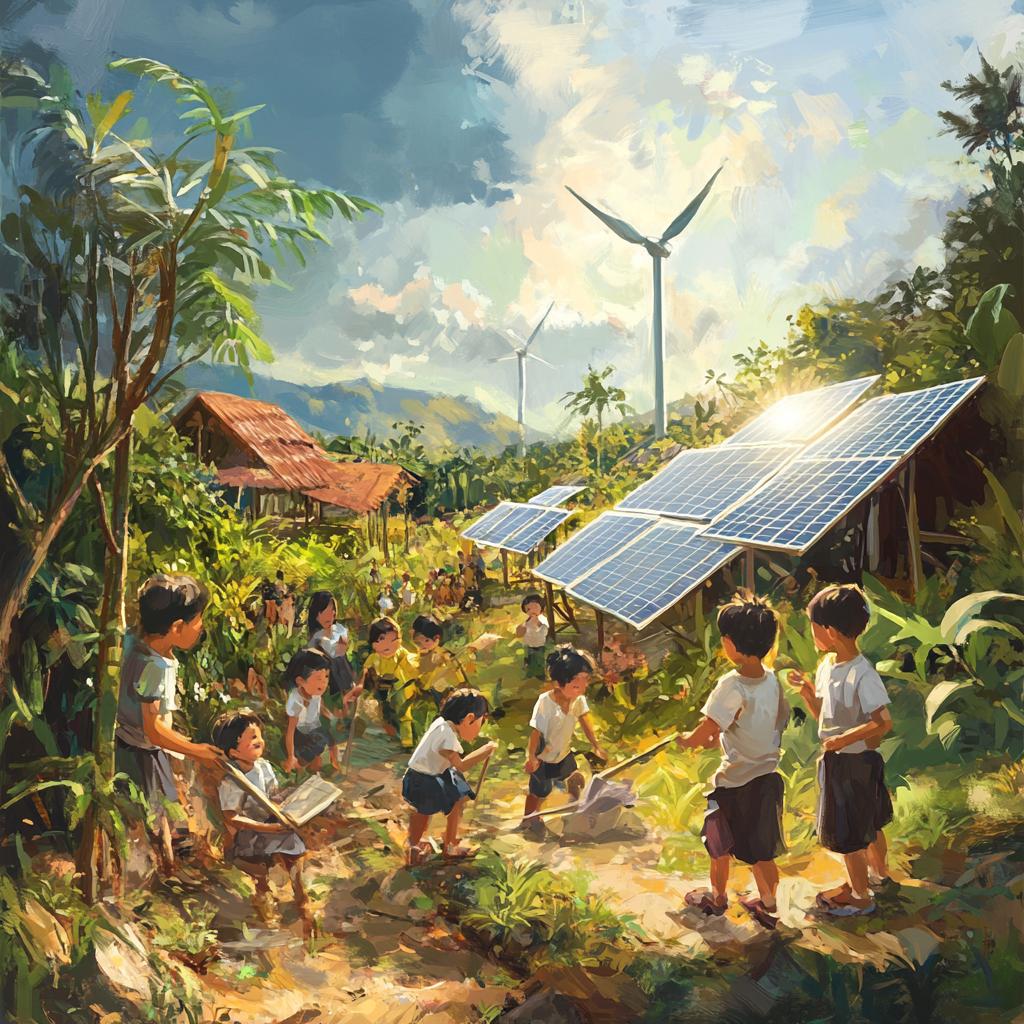In the vibrant corridors of Ruamrudee International School, a remarkable gathering of young minds is sparking a transformative movement. This passionate ensemble, led by the enterprising Puvit Seetisarn, has embarked on a renewable energy quest with the potential to illuminate lives and power promising futures. Dubbed “LumenAid,” this initiative draws together four fervent teammates—Tarawin Kiatlertpongsa, Siravij Ninyawee, Parin Pasutharachati, and Pimphaporn Chonviriyabun—who collectively share an ambitious vision to harness the sun and wind, kindling hope in underserved communities.
Their mission, as impressive as it is compassionate, took flight with a groundbreaking feat at the Ban Pilok Khi Border Patrol Police School nestled in the inspiring landscapes of Kanchanaburi province. There, in the project’s jubilant first year, the team engineered and inaugurated a solar-powered water pump system. This marvel of ingenuity now draws life-giving water from a distant river, over 700 meters away and a daunting 80 meters below the school, ensuring a never-ending flow for thirsty students and diligent teachers alike.
Building on their initial triumph, the LumenAid team took their luminous touch to Baan Pa Mak Border Patrol Police School in the scenic expanse of Prachuap Khiri Khan. By early April 2026, these young innovators had conjured yet another spectral wonder—solar-powered walkway lights that gracefully bathe the school grounds and sports fields in welcoming night-time illumination. Alongside this radiant addition, they inspired local students through engaging workshops focusing on language, hygiene, and personal development, fostering a blend of academic and personal growth.
Their radiant aspirations don’t stop at Thailand’s borders. Demonstrating a boundless commitment to humanitarian aid, the group extended their initiative to earthquake-stricken Myanmar. Within the heart of crisis relief efforts, they donated 20 solar-powered lamps alongside two Powerbox units—nimble, portable powerhouses of solar-generated electricity. In a gesture that spoke volumes about goodwill and collaboration, Rear Admiral Piyasak Nilnimit, serving as the Deputy Director-General of the Department of Military Civil Affairs, graciously accepted these beacons of hope, destined for communities left in the dark after devastating building collapses.
From the seeds of a humble school project, LumenAid has blossomed into a collaborative symphony involving esteemed educational compatriots such as Harrow International School and The Newton Sixth Form School. Together, they are widening the reach of their luminous mission, crafting novel solutions, and championing a sustainable future through the fusion of education and cutting-edge technology.
More than just a youthful endeavor, LumenAid encapsulates the power of spirited innovation and collective dedication. These dynamic Thai students have artfully illustrated how the synergy of enthusiasm and ingenuity can bring light—both in the literal sense and metaphorically—to those who yearn for it most. In doing so, they are not just lighting up communities; they are illuminating the path toward a more sustainable and compassionate world.


















I think what these Thai students are doing with LumenAid is incredible! It’s inspiring to see young people making such a tangible impact with renewable energy solutions.
True, but do you really think small projects like this can make a global difference? We need massive shifts led by big corporations.
Every little bit counts! Grassroots initiatives can lead to major societal changes. If every community had one project like this, imagine the cumulative impact.
While the story is heartwarming, it’s important to question how these youths get funded. Is it purely a nonprofit project or do they have corporate backing?
Interesting point! Often these projects are initially self-funded or supported by small grants, but as they grow, they might attract other funding sources.
These students need to focus on their studies! While noble, shouldn’t their education come first?
Isn’t practical application a part of learning? They’re gaining invaluable experience while helping others!
I suppose real-life experience does count for something, but they shouldn’t sacrifice their academics.
The scalability of solar projects can truly redefine energy access in rural areas. With enough support, LumenAid could put significant pressure on traditional energy structures.
I wonder why schools in developed countries aren’t pursuing similar projects. Seems like a great opportunity for educational growth and environmental benefit.
Critics should note: solutions like solar pumps and lamps aren’t always feasible everywhere, but they can be vital in remote and off-grid areas.
What they’re doing is pure magic – turning sunlight into electricity to light up someone’s life! Where can I sign up to help?
Check their website or reach out to environmental clubs in your area. These projects often welcome volunteers and donations.
This makes me hopeful for the future. Young people leading the charge against environmental issues shows that change is possible if we invest in educating the youth.
People always act like solar is the future. What about nuclear power? It’s a lot more efficient.
Nuclear has merits, but it comes with risks like waste disposal and safety issues. Solar is safer and getting cheaper!
Both forms of energy have their place. Let’s not diminish the student’s work by comparing it to nuclear energy. Every step towards sustainability is crucial.
I wish these kinds of initiatives were more common in Western education systems. Practical solutions driven by students are the way forward!
Schools often have limited budgets and competing priorities, which can make launching similar initiatives challenging.
The key to success here is hands-on involvement. These students are not just learning about change; they’re actively pioneering it!
Wouldn’t it be great if more international aid focused on sustainable solutions like this? So much more lasting value.
I agree, but international aid often gets tangled in red tape and political agendas. Projects driven by students can sometimes bypass these issues.
LumenAid’s international scope shows the power of young global citizens. Hope their story gets coverage in more publications.
I’m particularly impressed by their expansion to Myanmar. Sharing light amidst crisis highlights the project’s humanitarian core.
This is a wonderful example of cross-border collaboration. We need more of this approach in global development work.
True, though I remain skeptical about small projects having long-term impacts without substantial follow-up support.